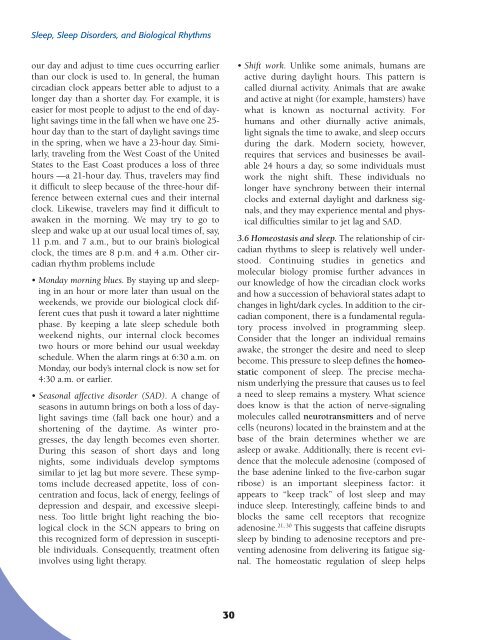Biological - NIH Office of Science Education - National Institutes of ...
Biological - NIH Office of Science Education - National Institutes of ...
Biological - NIH Office of Science Education - National Institutes of ...
Create successful ePaper yourself
Turn your PDF publications into a flip-book with our unique Google optimized e-Paper software.
Sleep, Sleep Disorders, and <strong>Biological</strong> Rhythms<br />
our day and adjust to time cues occurring earlier<br />
than our clock is used to. In general, the human<br />
circadian clock appears better able to adjust to a<br />
longer day than a shorter day. For example, it is<br />
easier for most people to adjust to the end <strong>of</strong> daylight<br />
savings time in the fall when we have one 25-<br />
hour day than to the start <strong>of</strong> daylight savings time<br />
in the spring, when we have a 23-hour day. Similarly,<br />
traveling from the West Coast <strong>of</strong> the United<br />
States to the East Coast produces a loss <strong>of</strong> three<br />
hours —a 21-hour day. Thus, travelers may find<br />
it difficult to sleep because <strong>of</strong> the three-hour difference<br />
between external cues and their internal<br />
clock. Likewise, travelers may find it difficult to<br />
awaken in the morning. We may try to go to<br />
sleep and wake up at our usual local times <strong>of</strong>, say,<br />
11 p.m. and 7 a.m., but to our brain’s biological<br />
clock, the times are 8 p.m. and 4 a.m. Other circadian<br />
rhythm problems include<br />
• Monday morning blues. By staying up and sleeping<br />
in an hour or more later than usual on the<br />
weekends, we provide our biological clock different<br />
cues that push it toward a later nighttime<br />
phase. By keeping a late sleep schedule both<br />
weekend nights, our internal clock becomes<br />
two hours or more behind our usual weekday<br />
schedule. When the alarm rings at 6:30 a.m. on<br />
Monday, our body’s internal clock is now set for<br />
4:30 a.m. or earlier.<br />
• Seasonal affective disorder (SAD). A change <strong>of</strong><br />
seasons in autumn brings on both a loss <strong>of</strong> daylight<br />
savings time (fall back one hour) and a<br />
shortening <strong>of</strong> the daytime. As winter progresses,<br />
the day length becomes even shorter.<br />
During this season <strong>of</strong> short days and long<br />
nights, some individuals develop symptoms<br />
similar to jet lag but more severe. These symptoms<br />
include decreased appetite, loss <strong>of</strong> concentration<br />
and focus, lack <strong>of</strong> energy, feelings <strong>of</strong><br />
depression and despair, and excessive sleepiness.<br />
Too little bright light reaching the biological<br />
clock in the SCN appears to bring on<br />
this recognized form <strong>of</strong> depression in susceptible<br />
individuals. Consequently, treatment <strong>of</strong>ten<br />
involves using light therapy.<br />
• Shift work. Unlike some animals, humans are<br />
active during daylight hours. This pattern is<br />
called diurnal activity. Animals that are awake<br />
and active at night (for example, hamsters) have<br />
what is known as nocturnal activity. For<br />
humans and other diurnally active animals,<br />
light signals the time to awake, and sleep occurs<br />
during the dark. Modern society, however,<br />
requires that services and businesses be available<br />
24 hours a day, so some individuals must<br />
work the night shift. These individuals no<br />
longer have synchrony between their internal<br />
clocks and external daylight and darkness signals,<br />
and they may experience mental and physical<br />
difficulties similar to jet lag and SAD.<br />
3.6 Homeostasis and sleep. The relationship <strong>of</strong> circadian<br />
rhythms to sleep is relatively well understood.<br />
Continuing studies in genetics and<br />
molecular biology promise further advances in<br />
our knowledge <strong>of</strong> how the circadian clock works<br />
and how a succession <strong>of</strong> behavioral states adapt to<br />
changes in light/dark cycles. In addition to the circadian<br />
component, there is a fundamental regulatory<br />
process involved in programming sleep.<br />
Consider that the longer an individual remains<br />
awake, the stronger the desire and need to sleep<br />
become. This pressure to sleep defines the homeostatic<br />
component <strong>of</strong> sleep. The precise mechanism<br />
underlying the pressure that causes us to feel<br />
a need to sleep remains a mystery. What science<br />
does know is that the action <strong>of</strong> nerve-signaling<br />
molecules called neurotransmitters and <strong>of</strong> nerve<br />
cells (neurons) located in the brainstem and at the<br />
base <strong>of</strong> the brain determines whether we are<br />
asleep or awake. Additionally, there is recent evidence<br />
that the molecule adenosine (composed <strong>of</strong><br />
the base adenine linked to the five-carbon sugar<br />
ribose) is an important sleepiness factor: it<br />
appears to “keep track” <strong>of</strong> lost sleep and may<br />
induce sleep. Interestingly, caffeine binds to and<br />
blocks the same cell receptors that recognize<br />
adenosine. 21, 30 This suggests that caffeine disrupts<br />
sleep by binding to adenosine receptors and preventing<br />
adenosine from delivering its fatigue signal.<br />
The homeostatic regulation <strong>of</strong> sleep helps<br />
30

















